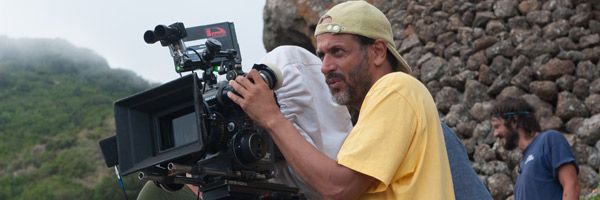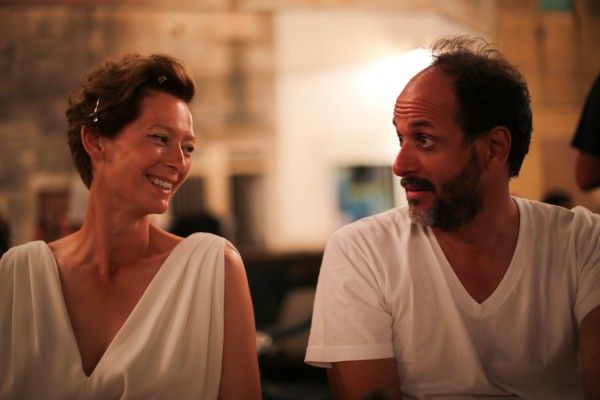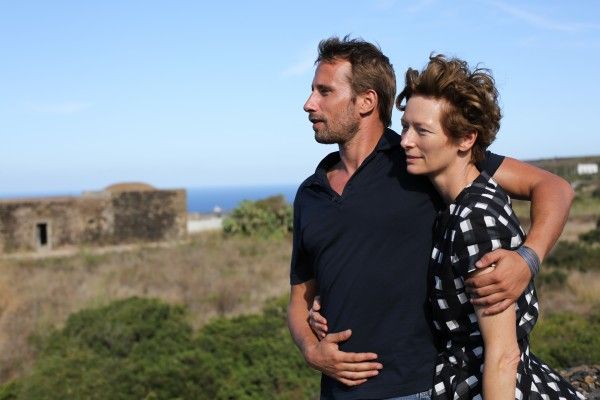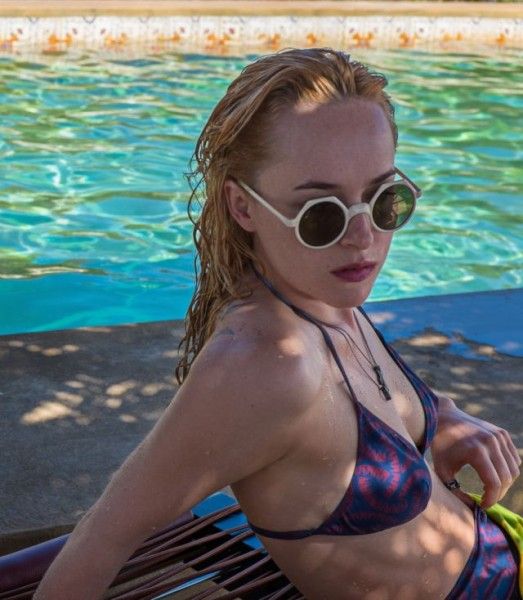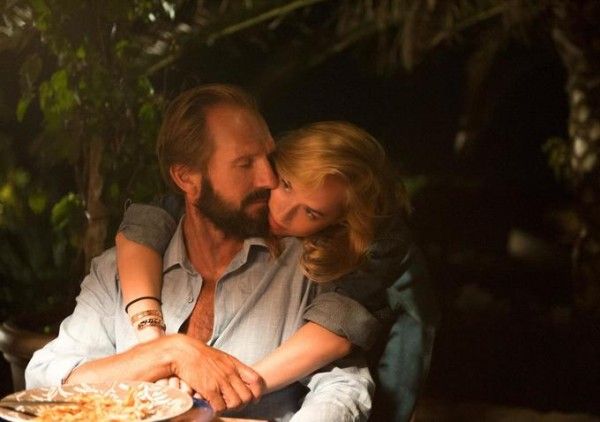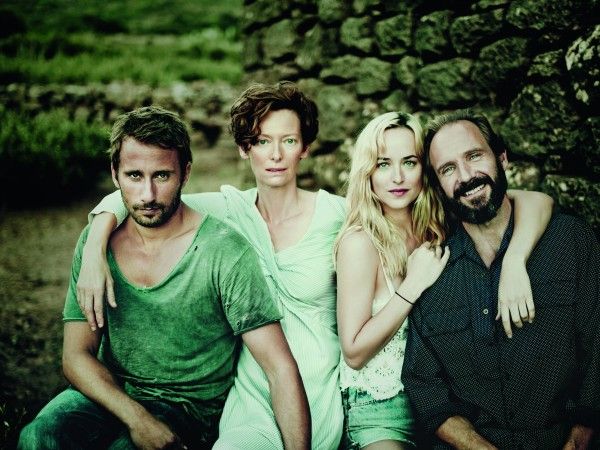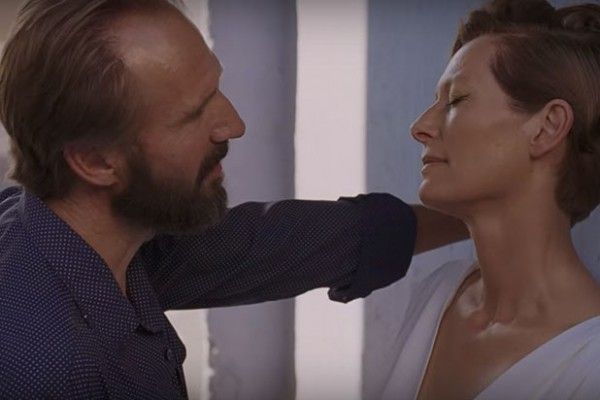Best known for his 2009 collaboration with Tilda Swinton for I Am Love (for which the actress famously learned Italian), Luca Guadagnino returns seven years later with the English-language A Bigger Splash, a modern reworking of the Jacques Deray classic La Piscine.
The film, which also features Ralph Fiennes as a motor-mouthed record producer, Dakota Johnson as a fatalistic ingenue and Matthias Schoenaerts as a deeply damaged documentarian, is a carefully calibrated pressure cooker of a thriller. Set on the Italian island of Pantelleria, one famously known for containing both gorgeous excess and for housing many African refugees, the tension-filled locale reflects the violence bubbling underneath ‘A Bigger Splash’s’ gorgeous exterior as the many personalities begin to clash amongst the vistas of the idyllic vacation spot.
Before the film hits U.S. theaters, I had a chance to sit down with Guadagnino to discuss his light-handed approach to remaking the French classic, his filmmaking philosophies, and his upcoming Suspiria remake.
QUESTION: I just spoke to David Kajganich, your screenwriter, and he said that when you first watched the film together, La Piscine, the original film, you watched it with no sound?
LUCA GUADAGNINO: For half an hour, then we switched it off.
Oh, wow. So how much did you keep yourself separated from that film? Did you watch it once and that was it?
GUADAGNINO: No, we tried to watch it, it didn’t work. So we had to switch it off, and that’s it.
So have you returned to it since?
GUADAGNINO: No.
Well, this one is far superior, so I’m not sure how much you missed. One of the ways in which it is so interesting though is how open you are to ambiguity. Was the decision to keep things very open-ended, or was it – did it just not end up particularly mattering?
GUADAGNINO: I wanted the audience to make up their mind. I wanted the audience to be able to come out of the movie by finding the answers to things that could have resonated from their own life. That’s why I generally am not favorable of displaying all the solutions through one side of the movie. I like what you said, to be able to prioritize things that are not the obvious one.
I’ve been told the idea of the island was something that sort of became a creative linchpin of the entire film, can you tell us about the choice behind Pantelleria?
GUADAGNINO: The island was the first element, with rock-n-roll that came on board. When they told me, “Would you like to remake La Piscine?” I said, “Yes, but I’m going to take the basic points: four people, jealousy, but I would bring that, and the jealousy is not there, I didn’t bring that actually, there is desire, and I will bring that to another place and with the legacy of rock-n-roll.” And so the legacy is not a place, the place is Pantelleria. It is a beautiful and political place in the same time. I wanted the place to push those neurotic people that were invested only in one another and I wanted to make sure there was an element of otherness and outerness that could shape those people and say, “Hello, wake up, see what’s happening around you.”
Was the island the decision that sort of opened things up for you and made you agree to take this remake idea that StudioCanal had been pushing to you?
GUADAGNINO: No, it was not the island. It was the idea of telling a story through the lens of relationship. And to make a movie in which I could make performance be so connected with the actual behavior of someone in the desire for the other. To make a character piece about grown up people, that was interesting to me.
You’re a very specifically visual director, and working with the same cinematographer, albeit in a very different locale than the one in I Am Love, what is your visual approach? Do you come at the film that way?
GUADAGNINO: Well, the story is this. I am a film director and I work with a visual language, with a visual medium. And I try to make virtue of the use of this visual medium. And I try to make sure what I do speaks the language of cinema. I try to look for the position of the camera in order for that to be the only possible position given the story and the characters. I try to tend not to be in the position in which my movie has to be rooted in the cliche of the staging of the scene, I don’t do master and then cover myself. I try to make sure that the scene is a general movement.
I think you feel that especially in the dance sequence with Ralph. Can you talk about the choreography for that and the day on set?
GUADAGNINO: Well, the story that – we wanted to make that scene, we wanted the character to unleash his restraints. No restraints and just deep down go into his own enjoyment of dance but also nostalgia for something that is not going to be anymore. So we wanted to unlock from Ralph that kind of movement from Ralph without specific choreography. And it took a few months for him to work on it. And then when we got on set, I said to myself, “The great musicals, they have long takes, not too many cuts and they have to show the figure in the space.” So that’s how I shot it. A figure in a space.
I was wondering if you could tell us how you go about using visuals to sort of explain relationships between characters, specifically between Matthias and Ralph’s characters.
GUADAGNINO: Yeah, I think, when they speak in the car, you have this very long shot in which they drive the car and they talk. These two men, bare chested, they are talking casually about stuff but everything they’re saying means something more. And as I said before, Harry’s really pushing this guy. And I wanted that to be just one shot because I wanted, speaking of visual communication, because I wanted to create a visual state in which the audience could see the unfolding history of their relationship. And where these things could have led. In fact, without that scene you wouldn’t understand what happens next. When you have great performers and have set your movie in the right direction, it’s a beautiful privilege to let the camera watch the action unfold without spoken words.
How did things change once you knew Tilda wasn’t really going to be speaking for the majority of the film?
GUADAGNINO: It’s like, I have this great friend who is this three-star Michelin chef. And sometimes I go visit him and he says to me, “I’m doing an artichoke.” And he shows me this artichoke and I eat it and it’s fantastic, and a few months later I go back there and he says to me, “Okay, I have this artichoke.” And he brings me the artichoke and it’s nothing but completely different from what I had in the first place, he has changed it completely. And it’s fantastic, and even better, it’s a more precise piece of food. The idea that he went from something that was already great to something fantastic and that he discarded in the process what was already set up, it tells you how I work. I need to be constantly aware of the possibility of changing the route through which I’m going to the point. And so for me, she was an actress and talkative, she was a singer and silent? Perfect. It was a way to get to the story to be very precise. So it wasn’t a disruption. It was actually exciting.
In terms of Tilda’s character, obviously there’s a lot of things that you’ve protected in the screenplay, but I’m wondering when it came time to developing these characters, how much did you feel comfortable with the characters giving their input that may not have been in the screenplay or in your vision.
GUADAGNINO: Well, the point is that filmmaking is a collaborative effort, it isn’t about imposing your vision on other people. It’s about the talking, you know? There is this play about Jung and Freud & Sabina Spielrein called The Talking Cure. I think you can say the same thing about filmmaking, it’s a talking cure. You cure your sense of storyline, storytelling by the actual conversation with your collaborators: they can be the actors, they can be the director behind the camera, they can be the studio people, you talk to people, you listen to people, you let people listen to your own voice. Then, from there, you sort out the most coherent and precise, I hope, choice you can for your own film. So it’s not about: I have a vision, they have a vision, who’s going to win over who. I think the movie is about who is going to win over who, but my filmmaking experience is let’s all make love together in great harmony. So in the case of Marianne Lane, we this phenomenal costume designer called Giulia Piersanti, and I invited Giulia to collaborate with Raf Simons, and Raf was the creative director of Dior. And so we felt, let’s collaborate with Dior. And we then discussed the choices of Marianne Lane’s identity through the costumes with Tilda because of course Tilda and I and the costume department, we all have a great conversation to be had. And we all made our work onscreen the most precise depiction of Marianne Lane possible.
When I spoke to David Kajganich, he said one of the first things you told him was that you wanted the film to have a Stones-y vibe to it. What was the motivation behind that?
GUADAGNINO: Because we wanted to root the Harry Hawkes character, which is a way around which everything spins in rock-n-roll history. We wanted him to be this boisterous rock-n-roll producer that we have all experienced directly or indirectly in our life. And you can’t deny that rock-n-roll is the Rolling Stones mostly, and you have to endorse that part of the history. Also because Harry is in his 50s, we had to go in an era of rock-n-roll. The era in which he was operating with them was a late-70s timeframe, the early 80s. Which I think is a neglected period of the Stones, which I love very much.
I want to make sure to ask about this, I’m very excited about Suspiria. I’m sure it’s in inchoate stages, but there have been rumblings that Dakota and Tilda will be in it.
GUADAGNINO: Tilda and Dakota are going to be in Suspiria.
Lovely! How far along are you in the process?
GUADAGNINO: We’re filming it in September.
Oh, that’s so exciting. Thank you so much!
GUADAGNINO: Thank you.

